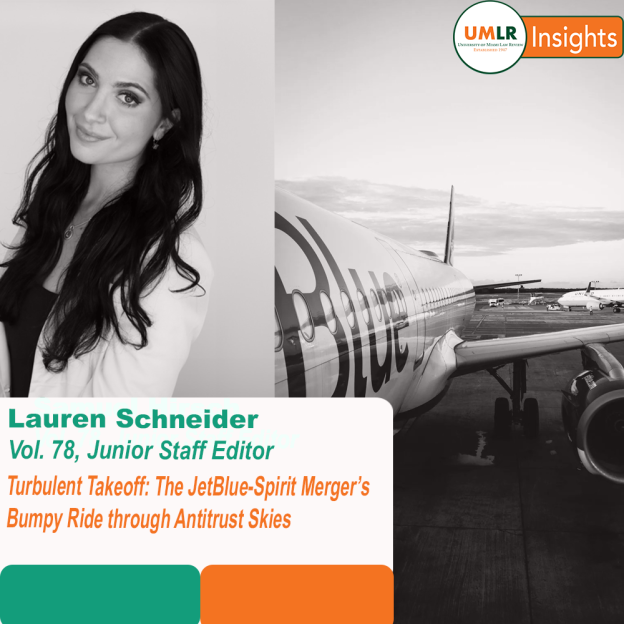LAUREN SCHNEIDER—Buckle up, frequent flyers, as turmoil is brewing on the tarmac. If you have kept tabs on the stock market recently, you might have noticed that Spirit Airlines took a nosedive in mid-January, with its shares falling by nearly fifty percent. This swift market downturn came hot on the heels of a U.S. District Judge’s ruling against JetBlue Airways’ proposed $3.8 billion acquisition of Spirit Airlines, citing concerns that the takeover would run afoul of antitrust laws.
The legal dispute initially commenced in March of 2023, when the Department of Justice filed a lawsuit alleging that the JetBlue-Spirit deal would curtail competition within the air travel industry, leading to increased consumer costs. Conversely, JetBlue contended that the Spirit acquisition was necessary to enhance its competitive edge against the “Big Four” airlines—American, Southwest, Delta, and United—who, as of last June, collectively absorbed seventy-four percent of flight capacity in the United States. Despite the recent block in federal court due to a violation of the Clayton Antitrust Act, which prohibits mergers and acquisitions when “the effect of such acquisition may be substantially to lessen competition,” JetBlue and Spirit filed an appeal, set to be heard this upcoming June.
The Department of Justice, along with some antitrust commentators, find the tentative JetBlue-Spirit merger to be especially troublesome due to Spirit’s prominent reputation as an “ultra low-cost” carrier, or “ULCC.” As the United States’ largest ULCC, a significant portion of travelers depend on Spirit as their go-to option for budget-friendly travel costs. Spirit’s attractive pricing model exerts pressure on other airlines to maintain competitiveness by lowering their own fares, resulting in better overall market affordability—referred to, by some, as the “Spirit Effect.” Therefore, if Spirit were eliminated as a key market competitor, the cost of airfare would purportedly surge.
Because JetBlue and Spirit’s routes overlap in at least 183 markets—even competing with one another on fifty-one nonstop routes—it is suspected that the merger would result in JetBlue controlling a significant percentage share of the market, with a significant increase in the concentration of that market. While the federal judge barred the deal based on the theory that JetBlue might use its new size to stop offering cut-rate fares, JetBlue further damaged its own cause after mistakenly releasing documents regarding its post-merger plans, which called for striking approximately twenty-four seats from all Spirit aircrafts and increasing fares by forty percent.
Nevertheless, the Clayton Act requires proof of a “substantial threat of competition” or a tendency to “create a monopoly,” and some critics argue that the government failed to meet its burden here—the recent ruling amounting to judicial policymaking, rather than the bona fide application of antitrust law. While the Big Four currently controls seventy-four percent of the market, a JetBlue-Spirit merger would likely only spur about a ten percent market share. Arguing that consumer welfare would actually be harmed by the ruling, a number of JetBlue-Spirit advocates contend the merger would foster a fifth major airline—rather than shielding the Big Four from competition—cut costs, and expand JetBlue’s fleet and routes.
Furthermore, critics claim by thwarting the merger, Spirit risks facing bankruptcy. If Spirit is ousted as a competitor due to financial ruin, its shareholders could lose out completely and fewer flights may mean higher fares—ironically, the precise situation that the government claimed to try to prevent. This prompts consideration as to whether impeding the Spirit-Jetblue merger truly serves the public interest, or if governmental intervention in the industry has overstepped, potentially disrupting healthy competition and favoring larger airlines.
Irrespective of one’s viewpoint on the matter, the rising judicial crackdowns on the consolidation of air travel, based on alleged anticompetitive effects, suggest a serious departure from an era characterized by widespread airline mergers. During the latter part of the 2000s, the trend of airline consolidation flourished, exemplified by Delta Air Lines’ 2008 acquisition of Northwest Airlines, United Airlines’ 2010 takeover of Continental Airlines, and Southwest Airlines’ 2011 purchase of AirTran Airways.
Unfortunately for JetBlue, this was not the first deal to be hampered within the last year. In 2023, JetBlue terminated its Northeast partnership with American Airlines after losing yet another antitrust battle against the Department of Justice. Despite a desire for expansion, these governmental setbacks have presented significant hurdles to JetBlue in the fiercely competitive aviation industry—an obstacle that other major airlines are likely to face moving forward.
While there are uncertainties on the horizon regarding JetBlue and Spirit’s appeal, the latest decision to suspend the merger sends out a clear signal to other established airlines—endeavors to further condense the airline industry will not be met without resistance. In navigating this increasingly stringent regulatory landscape, airlines—such as Alaska and Hawaiian airlines, currently in discussions over a $1.9 billion merger deal—must now tread carefully when structuring transactions with other players, considering their potential effects on competition and consumer welfare.






